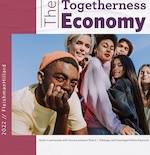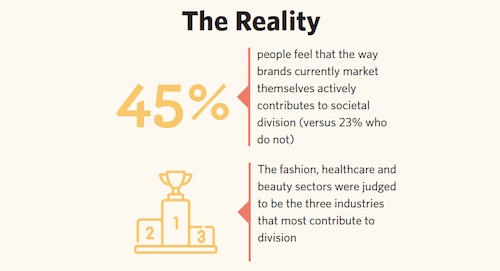 |
Brands are in a key position to foster social togetherness, according to a new study from FleishmanHillard’s TRUE Global Intelligence unit.
“The Togetherness Economy,” which was made in partnership with Harvard professor Robert J. Waldinger and futurologist Martin Raymond, surveyed 2,000 adults in the US and UK (1,000 in each country) between March 30 and April 7. It found that a solid majority (61 percent) of respondents feel that “brands have an important role to play when it comes to fostering togetherness in society.”
That sentiment has a direct connection to the bottom line, with 70 percent of US respondents claiming that they would be more likely to buy a product if its brand promoted togetherness. That number was not quite as high in the UK, where 54 percent of respondents said a brand’s stance on social togetherness would influence their purchasing decisions.
Related to that, respondents also said that a lack of social togetherness will impact their country’s economy—with 80 percent of US respondents and 70 in the UK agreeing.
 |
Equal representation across social groups in marketing and communications was seen as a central concern for many consumers. 86 percent of US respondents and 78 percent of those in the UK indicated that they want to see brand advertisements “accurately represent the make-up of society.”
But brands appear to be coming up short in meeting the desire for messaging that promotes social togetherness. Almost half (45 percent) agreed that the way brands currently market themselves actively contributes to societal division, with only 23 percent disagreeing.
The three sectors seen as the biggest contributors to social division were fashion, healthcare and beauty. “Of all consumer brands, they have arguably played the most prominent roles in perpetuating unattainable and one-dimensional beauty standards, and contributed most to gender stereotyping,” the report’s authors say.
The report offers some tips for how communicators can actively foster social togetherness in their efforts. Showing the values that people from different backgrounds share and making sure that a brand’s messaging stays consistent across all its audiences, it suggests, are two good places to start.
“Being alert to culture and how you demonstrate your stake in your community will be of critical importance,” says Raymond in an essay accompanying the study. “Communications must demonstrate your actions and your track record in being part of the cohesive communities of the future.”


 Consumers who once demanded convenience now require consistent, multi-channel experiences that cater to them at every point. Brands must have a clear, audience-appropriate, and channel-specific voice across all platforms.
Consumers who once demanded convenience now require consistent, multi-channel experiences that cater to them at every point. Brands must have a clear, audience-appropriate, and channel-specific voice across all platforms. Employees at U.S. companies are experiencing high levels of burnout, but managers are lagging behind when it comes to their awareness of the problem
Employees at U.S. companies are experiencing high levels of burnout, but managers are lagging behind when it comes to their awareness of the problem Brand has a powerful effect on a company’s valuation, but the level of brand understanding in the investment community leaves a lot to be desired, according to a new study from Brodeur Partners, Interbrand and NewtonX.
Brand has a powerful effect on a company’s valuation, but the level of brand understanding in the investment community leaves a lot to be desired, according to a new study from Brodeur Partners, Interbrand and NewtonX. AI may still be viewed with a wary eye by most media pros, but its use is growing, according to a new study from Muck Rack.
AI may still be viewed with a wary eye by most media pros, but its use is growing, according to a new study from Muck Rack. A new study from Walker Sands says that some marketers have been putting the cart before the horse when it comes to the relationship between marketing channels and business outcomes.
A new study from Walker Sands says that some marketers have been putting the cart before the horse when it comes to the relationship between marketing channels and business outcomes.


 Have a comment? Send it to
Have a comment? Send it to 
No comments have been submitted for this story yet.